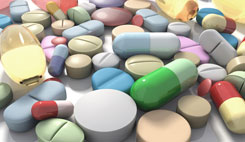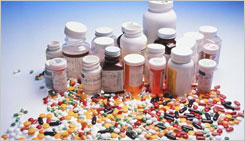DIGITAL VISION PHARMA "Once an addict decides to leave drugs irrespective of the nature and duration of drugs total deaddiction is possible, and that too painless", Yes, one can get rid of addiction irrespective of the amount and duration of intake. With modern era of medicines and with hi-tech medicines and techniques available deaddiction is surprisingly not a difficult process.
Digital Vision offers you a wide range of de addiction medicines like Buprenorphine SL tabs , naltrexone tabs etc.
Products Description
Bucet Plus is Buprenorphine 2 mg and Naloxone - 0.5 mg
Available as sub lingual tablets.
| Sr. No. | NAME | PACKING | MRP |
|---|---|---|---|
| TABLETS | |||
| 1 | TAB BUCET-0.2 Buprenorphine Hcl 0.2 mg |
10X2X08 B/P | 50.00 PER 10TAB. |
| 2 | TAB BUCET-0.4 Buprenorphine Hcl 0.4 mg |
10X10 B/P | 100.00 PER 10 TAB. |
| 3 | TAB BUCET-1 Buprenorphine Hcl 1 mg |
10X10 B/P | 220.00 PER 10 TAB. |
| 4 | TAB BUCET-PLUS Buprenorphine Hcl 2 mg. + naloxone 0.5 mg. |
10X10.B/P | 380.00 PER 10 TAB. |
| 5 | TAB BUPET-N Buprenorphine Hcl 2 mg. + naloxone 0.5 mg. |
10X10.B/P | 430.00 PER 10 TAB. |
| 6 | TAB BUCET-2 Buprenorphine Hcl 2 mg |
10X10 B/P | |
Pharmacodynamics
Buprenorphine Pharmacological studies have shown that buprenorphine has a partial agonist profile at the mu opiate receptor and is an antagonist at the kappa opiate receptor.
Naloxone has an extremely high affinity for μ-opioid receptors in the central nervous system. Naloxone is a μ-opioid receptor competitive antagonist, and its rapid blockade of those receptors often produces rapid onset of withdrawal symptoms. Naloxone also has an antagonist action, though with a lower affinity, at κ- and δ-opioid receptors.
Pharmacokinetics
Buprenorphine tablets are absorbed within 5-10 minutes. Peak plasma concentration is reached within 1-1.5 hrs. the median systemic availability was 16%. The long term terminal half life revealed by the chronic dosing kinetics suggests that it may take up to 10 days for steady plasma drug concentrations to be achieved by sublingual dosing alone. Buprenorphine is metabolized in humans by N-dealkylation and conjugation of dealkylation and conjugation of N-dealkylbuprenorphine and the parent drug; about 70% of a radioactive oral or intravenous dose is recovered in feces and most of the remainder appears in the urine. Buprenorphine and its glucuronide appears in the urine in 1-2 days.
Naloxone is only minimally absorbed when given orally as it is rapidly destroyed in the GI tract. Much higher doses are required if using this route of ad¬ministration for any pharmacologic effect. When given IV, naloxone has a very rapid on¬set of action (usually 1-2 minutes). If given IM, the drug generally has an onset of action within 5 minutes of administration. The duration of action usually persists from 45-90 minutes, but may act for up to 3 hours.
Naloxone is distributed rapidly throughout the body with high levels found in the brain, kidneys, spleen, skeletal muscle, lung and heart. The drug also readily crosses the pla¬centa.
Naloxone is metabolized in the liver, principally via glucuronidative conjugation with metabolites excreted into the urine. In humans, the serum half-life is approximately 60-100 minutes
How it should be taken: It comes as a tablet to be placed under the tongue, with or without food.
Special Instructions:
Side Effects:
Pregnancy and lactation:
No safety and efficacy profile has been established, not advisable.
Pediatrics:
Not advisable in children below 16 yrs.
Drug interactions:
Doctor or pharmacist may already be aware of any possible drug interactions and may be monitoring you for them. Do not start, stop, or change the dosage of any medicine before checking with them first.Before using this medication, tell your doctor or pharmacist of all prescription and nonprescription products you may use, especially of: MAO inhibitors (e.g., furazolidone, linezolid, moclobemide, phenelzine, procarbazine, rasagiline, selegiline, isocarboxazid, tranylcypromine), drugs which decrease liver metabolism (inhibitors of cytochrome 3A4 enzymes such as itraconazole, ketoconazole, erythromycin, clarithromycin, ritonavir, indinavir, saquinavir), local anesthetics (e.g., bupivacaine), sedative drugs (benzodiazepines such as diazepam, lorazepam).Deaths have occurred when buprenorphine/naloxone has been misused, especially when used in combination with benzodiazepines (e.g., diazepam, lorazepam) or other depressants such as alcohol or additional narcotics.Also report the use of other drugs that cause drowsiness such as: medicine for sleep (e.g., sedatives), tranquilizers, anti-anxiety drugs (e.g., temazepam), narcotic pain relievers (e.g., codeine), psychiatric medicines (e.g., phenothiazines such as chlorpromazine, or tricyclics such as amitriptyline), anti-seizure drugs (e.g., carbamazepine), muscle relaxants, antihistamines that cause drowsiness (e.g., diphenhydramine).This document does not contain all possible interactions. Therefore, before using this product, tell your doctor or pharmacist of all the products you use. Keep a list of all your medications with you, and share the list with doctor and pharmacist.











